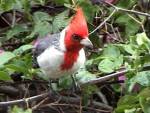


Yes, they have deer on Maui, and Brazilian cardinals, and just about anything else you can think of. Following dinner one night, our hosts took us into the yard to see some “chameleons.” Everyone calls the common green anole a chameleon, so I was not expecting much. However, sitting on a tree branch staring at me with one eye (and at our host with the other) was a Jackson’s chameleon. Hawaii may be a look into the future of the planet’s biodiversity. Although about a quarter of its native birds are extinct, some introduced species that are heading for extinction in their native habitat are thriving here.
Islands are especially sensitive to invasive species. Hawaii is not alone with its problems.
Taking pictures of introduced species in Hawaii is easy. Finding a driver for the camera and a free site to upload the photos to was also straightforward. (The internet is awesome.) Borrowing my teenage daughter’s laptop to upload them was more problematic.
Maui’s bike trails are excellent. They would get a lot more use if somebody were to open an electric bike shop here (hint).
A wind farm is visible in the distant hills. I wonder how much the power brokers bitched about having their views compromised.
The manicured golf courses and grounds of the tourist hangouts are as beautiful as they are sterile, which got me to wondering. Would most tourists even notice if the grass and flowers were fake? They sure as hell are not natural. Imagine the water, fertilizer, pesticides, and labor that plastic landscaping would eliminate. A better idea: join forces with the state, the Nature conservancy, and developers to create beach resorts that double as a wildlife preserves. Screw the manicured grounds; let them grow wild with native plants and turn the paths to the beaches and pools into nature trails. Make it a law that you must integrate golf courses with nature preserves as well. The landscapes would be much more interesting, and far less expensive to maintain (enhancing profit margins and ecosystems simultaneously).




